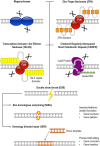Is Malaysia Ready for Human Gene Editing: A Regulatory, Biosafety and Biosecurity Perspective
- PMID: 33777918
- PMCID: PMC7992004
- DOI: 10.3389/fbioe.2021.649203
Is Malaysia Ready for Human Gene Editing: A Regulatory, Biosafety and Biosecurity Perspective
Abstract
Gene editing platforms have revolutionized the field of genetics with a direct impact on the public health system. Although there are apparent benefits, it is often accompanied by public debates over its uncertainties and risks. In the Malaysian context, modern biotechnology has raised questions about how to best govern gene editing in regulations, biosafety, and biosecurity. Even though standards and guidelines on stem cell and cell-based therapies have been developed, there are no appropriate legal frameworks available for gene editing yet. Nevertheless, biosafety regulations were established to balance promoting biotechnology and protecting against their potential environmental and human health risks. There is also a need to address the potential of genetically modified organisms (GMOs) as bioweapons. Numerous frameworks from several international organizations may provide valuable input in formulating documents on gene editing. By establishing comprehensive guidelines, legal policies, and standards to tackle the challenges and risks associated with gene editing, Malaysia can successfully apply this modern technology in this country.
Keywords: CRISPR; Malaysia; biosafety; biosecurity; gene editing; gene therapy; regulation.
Copyright © 2021 Kalidasan and Theva Das.
Conflict of interest statement
The authors declare that the research was conducted in the absence of any commercial or financial relationships that could be construed as a potential conflict of interest.
Figures

Similar articles
-
Comparison of Brazilian High- and Maximum-Containment Laboratories Biosafety and Biosecurity Regulations to Legal Frameworks in the United States and Other Countries: Gaps and Opportunities.Appl Biosaf. 2024 Mar 1;29(1):45-56. doi: 10.1089/apb.2023.0005. Epub 2024 Feb 28. Appl Biosaf. 2024. PMID: 38434103 Free PMC article.
-
Establishing a national biosafety and biosecurity agency for the United States.Front Bioeng Biotechnol. 2024 Oct 17;12:1474120. doi: 10.3389/fbioe.2024.1474120. eCollection 2024. Front Bioeng Biotechnol. 2024. PMID: 39483610 Free PMC article.
-
Toward the effective implementation of the Biosafety Protocol: a Chinese regulatory capacity-building perspective.J Law Biosci. 2025 Jun 3;12(1):lsaf011. doi: 10.1093/jlb/lsaf011. eCollection 2025 Jan-Jun. J Law Biosci. 2025. PMID: 40463477 Free PMC article.
-
Strengthening regulatory capacity for gene drives in Africa: leveraging NEPAD's experience in establishing regulatory systems for medicines and GM crops in Africa.BMC Proc. 2018 Jul 19;12(Suppl 8):11. doi: 10.1186/s12919-018-0108-y. eCollection 2018. BMC Proc. 2018. PMID: 30079102 Free PMC article. Review.
-
The Importance of Biosecurity in Emerging Biotechnologies and Synthetic Biology.Avicenna J Med Biotechnol. 2024 Oct-Dec;16(4):223-232. doi: 10.18502/ajmb.v16i4.16738. Avicenna J Med Biotechnol. 2024. PMID: 39606684 Free PMC article. Review.
Cited by
-
Biomaterials-mediated CRISPR/Cas9 delivery: recent challenges and opportunities in gene therapy.Front Chem. 2023 Sep 28;11:1259435. doi: 10.3389/fchem.2023.1259435. eCollection 2023. Front Chem. 2023. PMID: 37841202 Free PMC article. Review.
-
Advancing microbiota therapeutics: the role of synthetic biology in engineering microbial communities for precision medicine.Front Bioeng Biotechnol. 2024 Dec 4;12:1511149. doi: 10.3389/fbioe.2024.1511149. eCollection 2024. Front Bioeng Biotechnol. 2024. PMID: 39698189 Free PMC article. Review.
References
-
- Abdul Aziz M. F., Morrison M., Kaye J. (2018). Regulating human stem cell research and therapy in low- and middle-income countries: Malaysian perspectives. New Genet. Soc. 37 2–20. 10.1080/14636778.2017.1415137 - DOI
-
- Abuduxike G., Aljunid S. M. (2017). “Health biotechnology in Malaysia: issues and challenges faced by the innovative biotechnology firms,” in Innovation in Developing and Transition Countries, eds Tsvetkova A., Schmutzler J., Suarez M., Faggian A. (Cheltenham: Edward Elgar Publishing; ), 131–155. 10.4337/9781785369667 - DOI
-
- Academy of Sciences Malaysia (2009). Precision Medicine Initiative for Malaysia. Available online at: https://www.akademisains.gov.my/studies/sig/precision-medicine/. (Accessed March 29, 2020)
-
- Academy of Sciences Malaysia (2017a). Envisioning Malaysia 2050: A Foresight Narrative. Kuala Lumpur: Academy of Sciences Malaysia.
-
- Academy of Sciences Malaysia (2017b). Science & Technology Foresight Malaysia 2050: Emerging Science, Engineering & Technology (ESET) Study. Kuala Lumpur: Academy of Sciences Malaysia.
Publication types
LinkOut - more resources
Full Text Sources
Other Literature Sources

